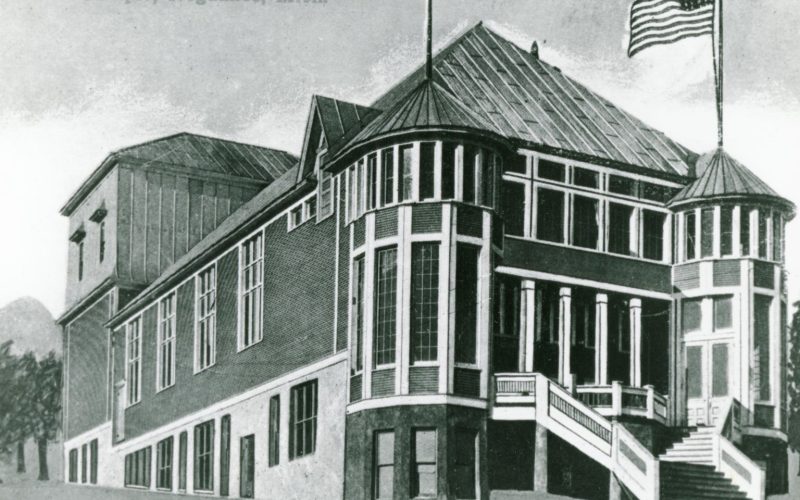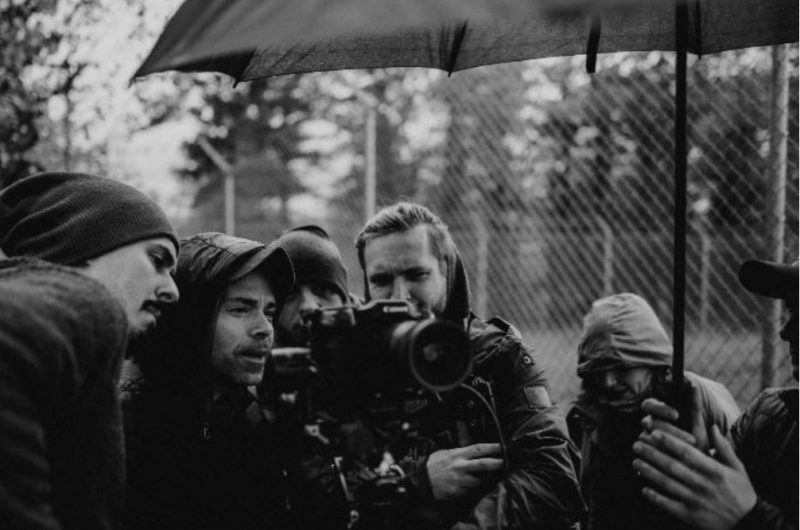The Festival of Struggle

The socialists and communists of the Upper Peninsula of Michigan strongly believed in the power of unifying, gathering, and creating a sense of community. In the early 1900s, immigrants and first-generation Finns led the charge in this unification. They organized public celebrations not only for their local neighbors, but for anyone willing to make the journey. Finns are historically known for their ability to organize celebration, and the leftists of the Upper Peninsula were no exception.
These leftists’ events were not always explicitly publicly promoted as “socialist” or “communist.” However, several newspapers local to the area used terms and phrases related to socialism such as “workers festival,” “co-operative,” “Reds,” or “labor.” The use of terms and phrases could camouflage the events’ political agendas to some of the less-read readers, while also making life harder for future researchers.
Marquette County and the whole of the Upper Peninsula experienced industrial and economic booms during the second Industrial Revolution that occurred between 1870 and 1914. These industries relied heavily on immigrant labor and the Great European Migration brought droves of new workers to the Upper Peninsula. Beginning in 1873, Finns steadily moved to areas in Michigan such as the Copper Country and Marquette County, creating dense Finnish cultural hubs.
While browsing the University of Minnesota’s online photo collections related to Finnish immigrants, I found several photos spanning July 2nd to the 4th 1932 depicting parades, marches, and sporting events. They were all cataloged with the titled of “Festival of Struggle” and located in Ishpeming and Negaunee, Michigan.
One photo had “Festival of Struggle” handwritten in the bottom-left corner and another had “Finnish Workers’ March” written across the top. These photos featured roads packed with marchers and a field full of athletes with hundreds of onlookers.
Given that there is photographic evidence of at least several hundred people participating in this event, it would be easy to assume that there would be vast documentation related to these three days. Neither the Marquette Regional History Center’s manuscripts and pamphlets, the University of Minnesota’s libraries and archives, nor the Northern Michigan Universities archives yielded any substantial information.
Even the several trusted books on Finnish Immigrants and socialism in the Great Lakes Region, which usually supply a tidbit of topical information, provided nothing. The only sources giving further information on this specific event are newspapers: the Daily Mining Journal, the Negaunee Iron Herald, and the Ishpeming Iron Ore; and even those were sparse on the topic.
During July 2nd through 4th of 1932, Marquette County newspapers published two short articles related to a festival for local farmers and workers. This three-day festival was a gathering of worker and farmer groups from across the Upper Peninsula with activities being held both in Ishpeming and Negaunee. The initial expectation was that a couple hundred people would show up, but the Negaunee Iron Herald noted that almost 2,500 people were in attendance.
The event’s actual name was the Festival of Struggle, but that term was not used in any of the 1932 news articles found on the topic. The festival featured programs, athletic competitions, music, a parade, and a dance. Throughout the three-day period, there would be almost continuous programs and events held at the festival’s headquarters, the Negaunee Labor Temple.
The parade began at 9am on July 3rd and included athletes of the Labor Sports Union marching in uniform, school age children, members of Young the Communist League, a band, and members of farmer and labor organizations.
To better understand the people participating in the festival, context on the important players and organization is needed. The Young Communist League organized and lead the groups of the young marchers. The Young Communist League, also referred to as the Young Worker’s League was created in 1920 following a split in the Socialist Party of American. The groups were an offshoot of the Communist International and acted as a youth group for the Communist Party of the United States. The marchers were being empowered and educated on the need for the emancipation of all workers.
One of the core beliefs of the Young Communist League was the importance of sports and the power they have in strengthening the Communist Party. In 1924, the Young Worker, a newspaper publication for the Communist Party in the United States, called for a communist sports movement. This movement looked to organize all labor athletes, including members of the American-Finnish Athletic Association, the Hungarian Young Workers’ League, and the American Sport Alliance of the Workers’ Party.
For the Festival’s parade, the march captains from two groups were identified in the photos from the University of Minnesota Library as Martin Maki with the Young Communist League, and Richard “Dick” Heikkinen with the Labor Sports Union gymnasts, both from Ishpeming, Michigan. Maki, a second generation Finnish American, participated in the Young Communist League’s 1929 International Youth Day Torchlight Parade and was an organizer for electrical workers. Heikkinen acted as the leader of the Young Communist League’s Upper Peninsula Branch and National Secretary of the Labor Sports Union at the time of the Festival of Struggle. Heikkinen was an avid racial justice activist and strong advocate for the desegregation of sports.
At the parade, the children participating where holding signs and banners expressing the group’s grievances, many following socialist themes. Specifically, the children could be seen bearing signs demanding free school lunch for all, and free clothing for the children of unemployed people. Following the parade, the rest of the day featured athletes from across the Upper Peninsula competing in sporting events at the Workers Athletic Park, 3 miles west of Ishpeming. The athletes at these events were not just competing for the viewer’s enjoyment, they were fighting for a spot at the International Workers Athletic Meet to be held in Chicago July 26th to August 1st. The winners were crowned at the festival’s headquarters, the Negaunee Labor Temple, Monday, July 4th at 8pm. Following the awards, a dance was held at the labor hall with a four-piece orchestra supplying the music.
Directing the athletic events was Unto (also spelled Undo) Immonen, a resident of Newberry, Michigan, an active communist, and a member of the International Labor Defense. Immonen was the manager of the Newberry Co-op Association who became infamous in 1933 following his arrest at Young Pioneer Camp in Eben Junction, Michigan. He, along with Eric Fahle Burman were charged with teaching children anarchy and violating Michigan’s “Red Flag” Law after news of a flag bearing the hammer sickle was spotted at the camp. The two were given four to eight years in prison but were freed following a reversal by the supreme court in 1935.
The authors of the Daily Mining Journal said that Festival of Struggle was an annual event, but no proof could be found prior to 1932. Just because there were no articles or advertisements for the event does not necessarily mean it did not occur. It is possible that there was little press given to the event, possibly due to the participant’s political leaning. Or it is also possible that 1932 was the first year it was held with plans to make it annual.
The next year, the festival was planned for the 4th of July and the days preceding. Three members of Marquette’s Labor Sports Union obtained the proper permits from the City of Ishpeming to host a parade on the 4th. Along with the permits there were several other rules the marchers had to follow including: a leader of the parade had to carry an American flag, the red hammer and sickle flag was not permitted to be flown, and any other flag or banner had to be okayed by the Mayor of Ishpeming.
At the time of the 1933 festival, displaying the “Red Flag” violated Chapter VIII, Act Number 328, Section 48 of the Michigan Penal Code that banned actions and paraphernalia related to anarchism and criminal syndicalism. The parade committee and local government agreed on four banners that were allowed to be carried related to their causes. Also included in the parades permit was the mayor and chief of police’s ability to cancel the parade if they deem it unreasonable. The parameters set where that the parade could not infringe on the public’s peace and quiet, and it could not interfere with the public’s access to the city’s streets.
At 9am on the 4th of July, around 1,000 people gathered to march in the Festival of Struggle. They were met with members of the police and fire department that where there to ensure that the parade did not violate any of the terms of their permit. The presence of the police led the parade committee to quickly convene. The committee decided that the best course of action was to cancel the parade, and caravan everyone to the Worker’s Athletic Park. There, they would continue with the athletic competitions.
This seems to be the last Festival of Struggle in Marquette County and likely all the Upper Peninsula. In 1934, a similar festival was held in Worcester, Massachusetts, also called the Festival of Struggle. The University of Minnesota’s Immigration History Research Center Archives has photos in their online collection depicting groups of Finnish gymnasts marching through the downtown of Worcester, just as they had in Ishpeming. This photo suggests a couple things: following the confrontation with police, the Festival of Struggle Committee relocated their event to Massachusetts, or more likely, the event was occurring nationally amongst leftist and Finnish groups.
Worcester, Massachusetts, Marquette, and the Upper Peninsula have several historical ties. Amos and Olive Harlow moved their family to Marquette around 1849 when there were only 136 people resided there. Former Worcester residents, Waterman Fischer and Edward Clark Joined them and started the Marquette Iron Company. This new settlement was originally called Worcester during early settlement, but had its name officially changed to Marquette, after the iron company, in 1950. The last historical tie is Työmies, a Finnish language socialist newspaper that was founded in Worcester before relocating to Hancock in 1904.
References
1932.”Festival of Struggle.” University of Minnesota Libraries, Immigration History Research Center Archives., Accessed December 21, 2022. https://umedia.lib.umn.edu/item/p16022coll135:371
“Alleged Reds Get Hearing.” The Sault Star. September 22, 1933.
Berger, Adam. “How did Marquette Get its Name?” Superior History. The Mining Journal. December 5, 2019. Accessed December 28, 2022. miningjournal.net/news/superior_history/2019/12/how-did-marquette-get-its-name/
Festival of Struggle. 1934. University of Minnesota Libraries, Immigration History Research Center Archives., umedia.lib.umn.edu/item/p16022coll135:1167 Accessed 21 Dec 2022.
“Farmers-workers’ Festival.” Negaunee Iron Herald. July 8, 1932.
“Festival for U.P. Workers, Farmers Group.” The Daily Mining Journal. July 2, 1932.
Kaunonen, Gary. Challenge Accepted: A Finnish Immigrant Response to Industrial America in Michigan. Lansing, MI: Michigan State University Press, 2010.
Kostianen, Auvo. Finns in the United States: A History of Settlement, Dissent, and Integration. Lansing, MI: Michigan State University Press, 2014.
Michelin, Rosemary. “Yankees Force the Way.” Recorded in Stone, Voices on the Marquette Iron Range. Accessed December 21, 2022. https://lib.nmu.edu/voices/yankees.php
“The Michigan Penal Code Act 328 of 1931.” Michigan Complied Laws Complete Through PA 219 & Includes 260-265, 275 & 280. 2014. Accessed December 29, 2022. http://www.legislature.mi.gov/documents/mcl/archive/2014/August/mcl-Act-328-of-1931.pdf
“Parade Called Off, Although Permit Issued.” The Daily Mining Journal. July 5, 1933.
“Reds Did not Parade.” Ishpeming Iron Ore. July 8, 1933.
“’Red Flag’ Case Nolle Prossed, Victims Free.” Marshfield News-Herald. October 30, 1935.
“’Red Flag Law’ is Used to Hold Two in Michigan Raid.” The Daily Worker. August 22, 1933.
Rock Maple Ridge Workers’ Association records, MSS-012, Central Upper Peninsula and Northern Michigan University Archives, Northern Michigan University.
“Track Meet at Workers’ Park Monday, July 3.” The Mining Journal. June 28, 1933.
“Undo Immonen.” The Mining Journal. November 14, 1992.
“The Young Communist League of America. Resolutions Adopted by the 2nd Convention of the United States Communist Party.” January 1921. From DoJ/FBI Investigation Files, NARA M-1085, reel 940, document 679. Accessed December 28, 2022. http://www.marxisthistory.org/history/usa/parties/cpusa/1921/0100-ucp-yclaresolution.pdf.






Fascinating!
Thanks, Sara!
Very interesting! Thank you for your work.
Thank you! I’m so glad I get to share my research!
Hunter
Very interesting piece. Great job on the research.
Thank you Tony! I’m happy you enjoyed it.
Very Interesting, especially with my Finnish heritage.
Thanks for checking it out!
Hard to imagine any leftist sympathies remaining in the UP, even though many common sense socialist ideas have become part of society for the greater good.
Thanks for reading, Rich. There definitely is a lot less today, compared to 100 years ago.
Could not agree with you more, Rich. Check out the election results in heavily Finnish Ontonagon County. Many of the descendants of Finnish leftists now vote overwhelmingly Trump Republican. They seem to have collective amnesia about their progenitors’ struggle for a more just society.
Awesome piece Hunter!
Thank so much for checking it out Tim!
Very interesting! Thank you for your research
Thanks Paula!